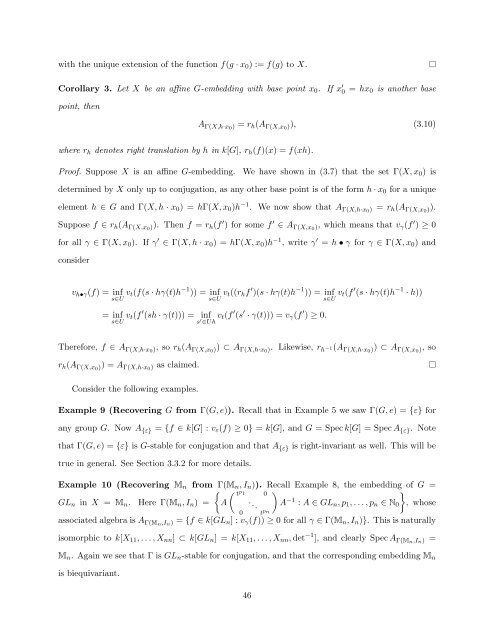Equivariant Embeddings of Algebraic Groups
Equivariant Embeddings of Algebraic Groups
Equivariant Embeddings of Algebraic Groups
Create successful ePaper yourself
Turn your PDF publications into a flip-book with our unique Google optimized e-Paper software.
with the unique extension <strong>of</strong> the function f(g · x 0 ) := f(g) to X.<br />
Corollary 3. Let X be an affine G-embedding with base point x 0 . If x ′ 0 = hx 0 is another base<br />
point, then<br />
A Γ(X,h·x0 ) = r h (A Γ(X,x0 )), (3.10)<br />
where r h denotes right translation by h in k[G], r h (f)(x) = f(xh).<br />
Pro<strong>of</strong>. Suppose X is an affine G-embedding.<br />
We have shown in (3.7) that the set Γ(X, x 0 ) is<br />
determined by X only up to conjugation, as any other base point is <strong>of</strong> the form h · x 0 for a unique<br />
element h ∈ G and Γ(X, h · x 0 ) = hΓ(X, x 0 )h −1 . We now show that A Γ(X,h·x0 ) = r h (A Γ(X,x0 )).<br />
Suppose f ∈ r h (A Γ(X,x0 )). Then f = r h (f ′ ) for some f ′ ∈ A Γ(X,x0 ), which means that v γ (f ′ ) ≥ 0<br />
for all γ ∈ Γ(X, x 0 ). If γ ′ ∈ Γ(X, h · x 0 ) = hΓ(X, x 0 )h −1 , write γ ′ = h • γ for γ ∈ Γ(X, x 0 ) and<br />
consider<br />
v h•γ (f) = inf<br />
s∈U v t(f(s · hγ(t)h −1 )) = inf<br />
s∈U v t((r h f ′ )(s · hγ(t)h −1 )) = inf<br />
s∈U v t(f ′ (s · hγ(t)h −1 · h))<br />
= inf v t(f ′ (sh · γ(t))) = inf v t(f ′ (s ′ · γ(t))) = v γ (f ′ ) ≥ 0.<br />
s∈U s ′ ∈Uh<br />
Therefore, f ∈ A Γ(X,h·x0 ), so r h (A Γ(X,x0 )) ⊂ A Γ(X,h·x0 ). Likewise, r h −1(A Γ(X,h·x0 )) ⊂ A Γ(X,x0 ), so<br />
r h (A Γ(X,x0 )) = A Γ(X,h·x0 ) as claimed.<br />
Consider the following examples.<br />
Example 9 (Recovering G from Γ(G, e)). Recall that in Example 5 we saw Γ(G, e) = {ε} for<br />
any group G. Now A {ε} = {f ∈ k[G] : v ε (f) ≥ 0} = k[G], and G = Spec k[G] = Spec A {ε} . Note<br />
that Γ(G, e) = {ε} is G-stable for conjugation and that A {ε} is right-invariant as well. This will be<br />
true in general. See Section 3.3.2 for more details.<br />
Example 10 (Recovering M n from Γ(M n , I n )). Recall Example 8, the embedding <strong>of</strong> G =<br />
{ ( t p 1 0<br />
GL n in X = M n . Here Γ(M n , I n ) = A . .. A −1 : A ∈ GL n , p 1 , . . . , p n ∈ N 0<br />
}, whose<br />
0 t pn )<br />
associated algebra is A Γ(Mn,I n) = {f ∈ k[GL n ] : v γ (f)) ≥ 0 for all γ ∈ Γ(M n , I n )}. This is naturally<br />
isomorphic to k[X 11 , . . . , X nn ] ⊂ k[GL n ] = k[X 11 , . . . , X nn , det −1 ], and clearly Spec A Γ(Mn,I n) =<br />
M n . Again we see that Γ is GL n -stable for conjugation, and that the corresponding embedding M n<br />
is biequivariant.<br />
46
















